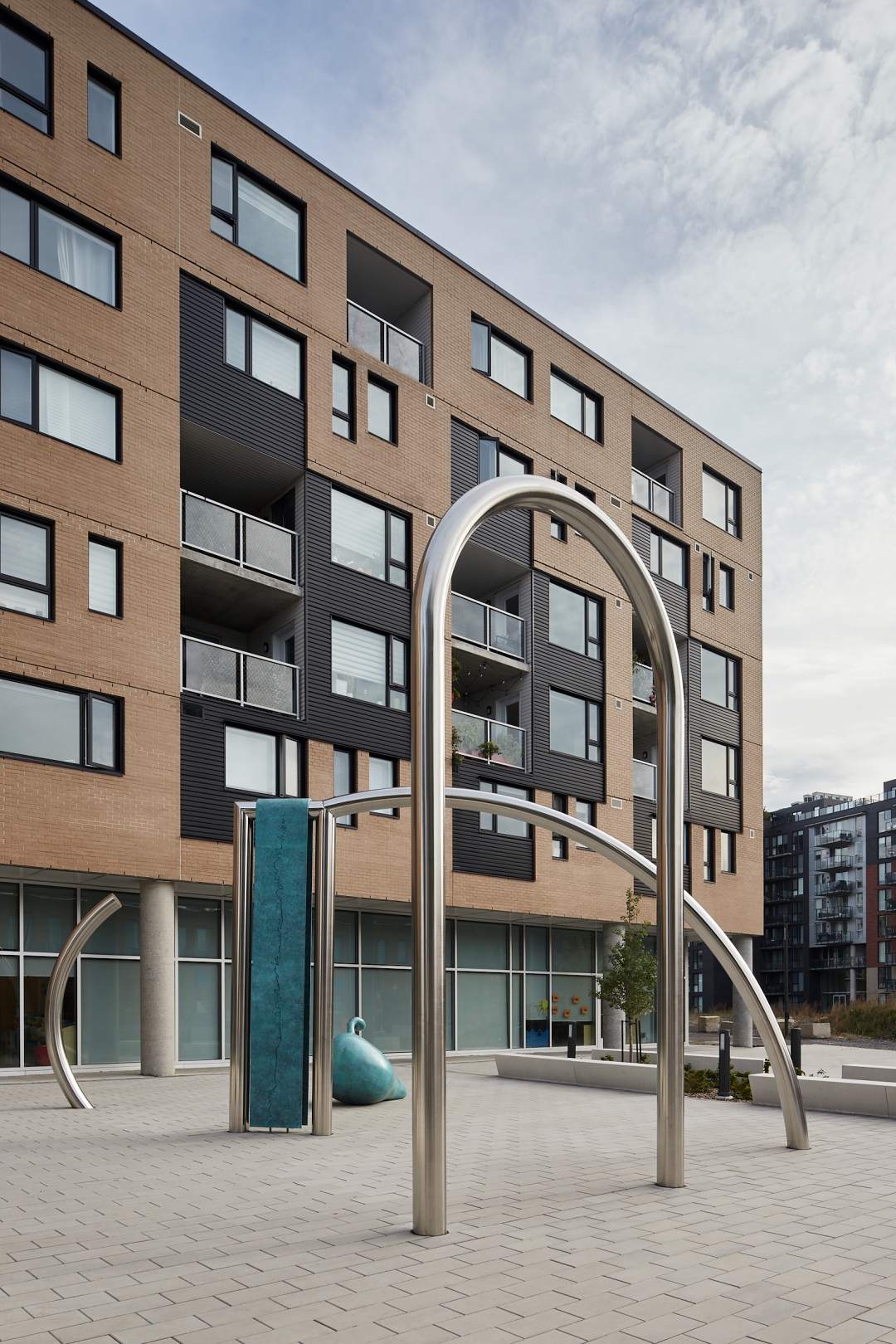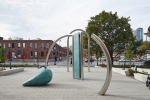Marie-Michelle Deschamps
Réciprocités
2022
Presentation of the artwork
The artwork Réciprocités is composed of an installation of simple shapes, relating three large arches made of stainless steel and two bronze elements: a hanging frieze with cut-out silhouettes of plants; and, on the ground, giving the impression of having become detached from one of the arches, a sculpture in the form of a milkweed pod. The 16 botanical specimens that compose the bronze frieze, like the shape of the milkweed sculpture, are borrowed from the herbarium The Lost Flora of Montreal, by Andrew Fernando Holmes (1797–1860), the botanist and founder of McGill University’s faculty of medicine.The tubular stainless-steel shapes of the three arches directly accentuate the industrial heritage of the Griffintown district.
Réciprocités bears witness to the exchange between the industrial past of the area and its current renewal. This work celebrates life returning to a flourishing neighbourhood.
Associated events
In February 2020, the Public Art Bureau held a competition by invitation for professional visual artists for the design and execution of an artwork for Place des Arrimeurs. The creation of this work falls within the Griffintown project. In May 2013, the Ville de Montréal adopted the Programme particulier d’urbanisme (PPU) – Secteur Griffintown, which presented both a vision of the neighbourhood and interventions developed by the Ville de Montréal to rehabilitate an industrial sector into a new innovative, inhabited, and sustainable neighbourhood. The PPU also recognizes the notion of the “cultural corridor of Ottawa Street” as a structural axis of Griffintown.
Marie-Michelle Deschamps
Marie-Michelle Deschamps’ work focuses on language as an inhabitable space– a veritable structure and place where aesthetic forms reside. Her practice is rooted within conversation, collaboration, and translation, underscoring the transformative place of language within the formal dialect of architecture.
Marie-Michelle Deschamps is based in Montreal, Canada, and holds an MFA in visual art from the Glasgow School of Art (Glasgow, Scotland). Deschamps’ work is part of the permanent collections of the Musée d’art contemporain de Montréal, the Voorlinden Museum (Wassenaar), the Lafayette Foundation (Paris), the Glasgow School of the Arts Libraries (Glasgow), the Enamel Arts Foundation (Los Angeles), and the Caisse de dépôt et placement du Québec (Montreal).
Marie-Michelle Deschamps is based in Montreal, Canada, and holds an MFA in visual art from the Glasgow School of Art (Glasgow, Scotland). Deschamps’ work is part of the permanent collections of the Musée d’art contemporain de Montréal, the Voorlinden Museum (Wassenaar), the Lafayette Foundation (Paris), the Glasgow School of the Arts Libraries (Glasgow), the Enamel Arts Foundation (Los Angeles), and the Caisse de dépôt et placement du Québec (Montreal).
Awards and honours
- Lauréate du programme de résidences Sobey, 2019
- Prix Art Trust Scotland, 2014
Presentation of the artwork
The artwork Réciprocités is composed of an installation of simple shapes, relating three large arches made of stainless steel and two bronze elements: a hanging frieze with cut-out silhouettes of plants; and, on the ground, giving the impression of having become detached from one of the arches, a sculpture in the form of a milkweed pod. The 16 botanical specimens that compose the bronze frieze, like the shape of the milkweed sculpture, are borrowed from the herbarium The Lost Flora of Montreal, by Andrew Fernando Holmes (1797–1860), the botanist and founder of McGill University’s faculty of medicine.The tubular stainless-steel shapes of the three arches directly accentuate the industrial heritage of the Griffintown district.
Réciprocités bears witness to the exchange between the industrial past of the area and its current renewal. This work celebrates life returning to a flourishing neighbourhood.
Associated events
In February 2020, the Public Art Bureau held a competition by invitation for professional visual artists for the design and execution of an artwork for Place des Arrimeurs. The creation of this work falls within the Griffintown project. In May 2013, the Ville de Montréal adopted the Programme particulier d’urbanisme (PPU) – Secteur Griffintown, which presented both a vision of the neighbourhood and interventions developed by the Ville de Montréal to rehabilitate an industrial sector into a new innovative, inhabited, and sustainable neighbourhood. The PPU also recognizes the notion of the “cultural corridor of Ottawa Street” as a structural axis of Griffintown.
Marie-Michelle Deschamps
Marie-Michelle Deschamps’ work focuses on language as an inhabitable space– a veritable structure and place where aesthetic forms reside. Her practice is rooted within conversation, collaboration, and translation, underscoring the transformative place of language within the formal dialect of architecture.
Marie-Michelle Deschamps is based in Montreal, Canada, and holds an MFA in visual art from the Glasgow School of Art (Glasgow, Scotland). Deschamps’ work is part of the permanent collections of the Musée d’art contemporain de Montréal, the Voorlinden Museum (Wassenaar), the Lafayette Foundation (Paris), the Glasgow School of the Arts Libraries (Glasgow), the Enamel Arts Foundation (Los Angeles), and the Caisse de dépôt et placement du Québec (Montreal).
Marie-Michelle Deschamps is based in Montreal, Canada, and holds an MFA in visual art from the Glasgow School of Art (Glasgow, Scotland). Deschamps’ work is part of the permanent collections of the Musée d’art contemporain de Montréal, the Voorlinden Museum (Wassenaar), the Lafayette Foundation (Paris), the Glasgow School of the Arts Libraries (Glasgow), the Enamel Arts Foundation (Los Angeles), and the Caisse de dépôt et placement du Québec (Montreal).
Awards and honours
- Lauréate du programme de résidences Sobey, 2019
- Prix Art Trust Scotland, 2014






